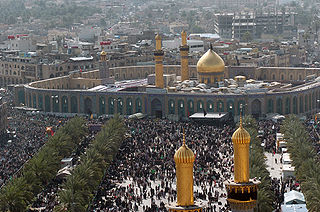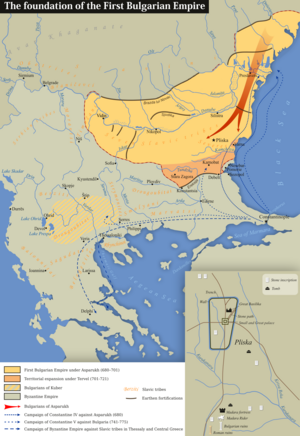The 710s decade ran from January 1, 710, to December 31, 719.
The 650s decade ran from January 1, 650, to December 31, 659.
The 660s decade ran from January 1, 660, to December 31, 669.
The 670s decade ran from January 1, 670, to December 31, 679.
The 680s decade ran from January 1, 680, to December 31, 689.

Year 695 (DCXCV) was a common year starting on Friday of the Julian calendar. The denomination 695 for this year has been used since the early medieval period, when the Anno Domini calendar era became the prevalent method in Europe for naming years.

Muḥarram is the first month of the Islamic calendar, and one of the four sacred months of the year when warfare is forbidden. The tenth of Muharram is known as Ashura, an important day of commemoration in Islam. For Sunni Muslims, the day marks the parting of the Red Sea by Moses and the salvation of the Israelites, celebrated through supererogatory fasting and other acceptable expressions of joy. By contrast, Ashura is a day of mourning for Shia Muslims, who annually commemorate the death of Husayn ibn Ali, grandson of the Islamic prophet Muhammad and the third Shia imam. Husayn was killed, alongside most of his relatives and his small retinue, in the Battle of Karbala in 680 CE against the army of the Umayyad caliph Yazid ibn Mu'awiya. The Shia rituals span the first ten days of Muharram, culminating on Ashura with mourning processions in Shia cities. Also in Muharram, the Aqsa mosque in Jerusalem was initially set as the direction of prayer for early Muslims.

In Shia Islam, Arba'in marks forty days after Ashura, which is the death anniversary of Husayn ibn Ali, grandson of the Islamic prophet Muhammad and the third Shia imam. Husayn was killed, alongside most of his relatives and his small retinue, in the Battle of Karbala on 10 Muharram 61 AH against the army of the Umayyad caliph Yazid ibn Mu'awiya. The battle followed Husayn's refusal to pledge his allegiance to Yazid, who is often portrayed by Muslim historians as impious and immoral. In Shia Islam, Karbala symbolizes the eternal struggle between good and evil, the pinnacle of self-sacrifice, and the ultimate sabotage of Muhammad's prophetic mission.

ʿAlī ibn al-Ḥusayn Zayn al-ʿĀbidīn, also known as al-Sajjād or simply as Zayn al-ʿĀbidīn, c. 4 January 659 – c. 13 October 713, was an Imam in Shiʻi Islam after his father Husayn ibn Ali, his uncle Hasan ibn Ali, and his grandfather, Ali ibn Abi Talib.
This is a timeline of major events in the Muslim world from 601 AD to 700 AD.

Al-Abbas ibn Ali ibn Abi Talib, also known as Abu al-Fadl, was a son of Ali ibn Abi Talib, the fourth caliph in Sunni Islam and the first imam in Shia Islam. His mother was Fatima bint Hizam, commonly known as Umm al-Banin. Abbas fought as the standard-bearer of his half-brother Husayn ibn Ali in the Battle of Karbala on 10 Muharram 61 AH against the army of the Umayyad caliph Yazid ibn Mu'awiya. He was killed in a desperate attempt to bring water from the Euphrates river to quench the unbearable thirst of the besieged family of the Islamic prophet Muhammad. Abbas is said to have inherited Ali's boldness and bravery, and was praised by Shia imams for his faith and fortitude in defending Husayn. Abbas is regarded by Shia Muslims as an ultimate paragon of courage and self-sacrifice. The shrine of Abbas and the nearby mausoleum of Husayn in Karbala are destinations for pilgrimage.
Umm Kulthūm bint 'Alī, also known as Zaynab al-Ṣughrā, was the youngest daughter of Fatima and Ali ibn Abi Talib. The former was the daughter of the Islamic prophet Muhammad and the latter was his cousin. Ali is also recognized as the fourth Rashidun caliph and the first Shia imam. A young Umm Kulthum lost her grandfather and mother in 632 CE. While she was still a child, the second Rashidun caliph Umar ibn al-Khattab asked for her hand in marriage, which was resisted by Umm Kulthum and her father Ali, possibly due to Umar's reputation for harsh treatment of women. By one Sunni account, Ali finally agreed to the marriage when Umar enlisted the support of prominent Muslims for his proposal.
Zaynab bint Ali, was the eldest daughter of Fatima and Ali ibn Abi Talib. The former was a daughter of the Islamic prophet Muhammad, and the latter was his cousin. Ali is also recognized as the fourth Rashidun caliph and the first Shia imam. Zaynab is best known for her role in the aftermath of the Battle of Karbala, in which her brother Husayn and most of her male relatives were massacred by the forces of the Umayyad caliph Yazid ibn Mua'awiya. Women and children in Husayn's camp were taken captive after the battle and marched to Kufa and then the Umayyad capital Damascus, where Zaynab gave impassioned speeches, condemning Yazid and spreading the news of Karbala. She was later freed and died shortly afterward in 682, but her burial site is uncertain. The two shrines associated with Zaynab in Damascus and Cairo are destinations for Muslim pilgrimage. She is considered to be a symbol of sacrifice, strength, and piety in Islam, and a role model for Muslim women, typifying courage, leadership, and defiance against oppression.
Al-Qāsim ibn al-Ḥasan was the son of Hasan ibn Ali. He supported his uncle Husayn ibn Ali in fighting off the Umayyad forces during the Battle of Karbala where he was killed at the age of 13.
Abd-Allah ibn al-Husayn, also known as Ali al-Asghar, was the youngest son of Husayn ibn Ali, the grandson of Muhammad and the third Shia Imam. A young child, likely an infant, he was killed in the Battle of Karbala in 680 CE, alongside his father, family members, and a small number of supporters, all of whom were massacred by the forces of the Umayyad caliph Yazid, who first surrounded them for some days and cut off their access to the nearby river Euphrates. Abd-Allah is commemorated in Shia Islam as the quintessence symbol of the innocent victim.
Ruqayya bint al-Ḥusayn is said to have been a daughter of Husayn ibn Ali, the third imam in Twelver Shia. Husayn and a small group of his supporters were massacred in the Battle of Karbala in 680 CE on the order of the Umayyad caliph Yazid. Their women and children were then taken captive and marched to the capital Damascus, where it is said that Ruqayya died at the age of about three, possibly due to the hostility of her captors. The shrine associated with Ruqayya in Damascus is a popular destination for Shia pilgrimage. The child of Husayn who died shortly after Karbala is sometimes identified as Sakina.
Rubāb bint Imraʾ al-Qays was the first wife of Husayn ibn Ali, the third Shia Imam. After some years of remaining childless, she bore Husayn two children, named Sakina and Abd-Allah, also known as Ali al-Asghar. Rubab was present at Karbala in 680 CE and witnessed there the massacre of her husband and his supporters by the forces of the Umayyad caliph Yazid. Also killed there was Ali al-Asghar, who was at the time a young child, likely an infant. The women and children, among them Rubab, were marched to Kufa and then the capital Damascus, where they were paraded in the streets and then imprisoned. They were later released and returned to their hometown of Medina. Rubab refused to remarry after Husayn and died about a year later in Medina. Some elegies are ascribed to her in memory of Husayn.
Sermon of Zaynab bint Ali in the court of Yazid are the statements made by Zaynab bint Ali in the presence of Yazid I in the aftermath of the Battle of Karbala when the captive family members of Muhammad, prophet of Islam, and the heads of those murdered were moved to the Levant by the forces of Yazid I. Zaynab delivered a defiant sermon in the court of Yazid in which she humiliated Yazid and exposed his army's atrocities while honoring the Ahl al-Bayt and those killed in Karbala and expounding upon the eternal consequences of the battle.
The Sermon of Ali ibn Husayn in Damascus are the statements of Ali ibn Husayn in the presence of Umayyad caliph Yazid I. After the Battle of Karbala, the captured family of Muhammad, the prophet of Islam, and the heads of those killed were moved to the Levant by the forces of Yazid. By order of Yazid, a pulpit was prepared, and a public speaker gave a lecture that placed blame on Ali and Husayn ibn Ali.In reply to the Yazid's speaker, Ali Ibn Husayn;introduced himself and his descendants. Also, he recounted the events leading to the death of Husayn ibn Ali.





